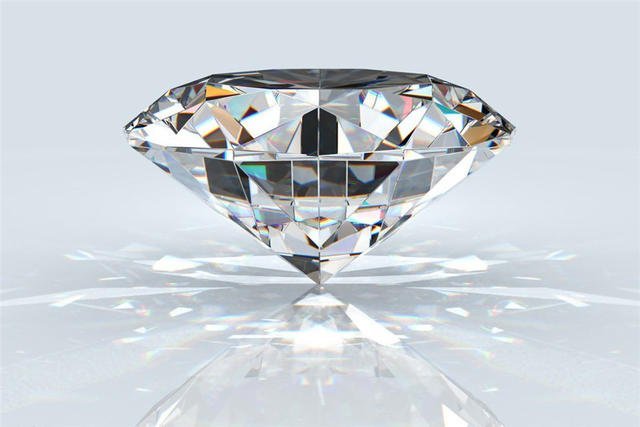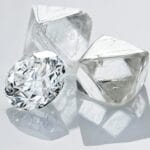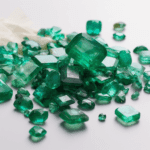The 4Cs of diamonds are carat weight, clarity, cut, and color. Each of these factors plays a crucial role in determining the overall quality and value of a diamond. I must mention here,Our Oveela Moissanite also follows the 4C’s of diamonds.
Carat:
Diamond carat refers to the weight of a diamond and is one of the most important factors in determining its value. One carat is equal to 0.2 grams or 200 milligrams. However, carat weight does not necessarily determine the size of a diamond. Two diamonds with the same carat weight can differ in size, depending on their cut and shape.

Diamonds are available in a range of carat weights, from less than 0.01 carats (also known as points) to over 10 carats. The average diamond engagement ring is around 1 carat. Larger diamonds are rarer and more valuable, which is why the price per carat increases exponentially as the carat weight of a diamond increases.
When choosing a diamond, it is important to consider carat weight in relation to the other 4Cs. A larger diamond may have a lower clarity or color grade, or a less ideal cut, which can affect its overall appearance and value. It is important to find a balance between carat weight and the other 4Cs to ensure that you are getting the best value for your money.
Clarity:
Diamond clarity refers to the presence or absence of inclusions and blemishes within a diamond. Inclusions are internal flaws, while blemishes are external flaws. These flaws can affect the appearance and value of a diamond.
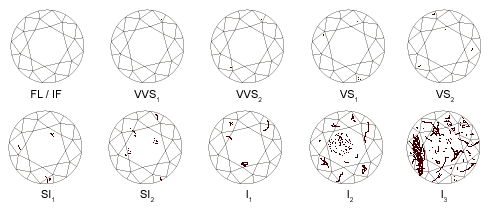
Diamond clarity is graded on a scale from Flawless (no inclusions or blemishes visible under 10x magnification) to Included (inclusions and blemishes visible to the naked eye). The clarity scale has six categories, each with several grades:
- Flawless (FL): No inclusions or blemishes visible under 10x magnification
- Internally Flawless (IF): No inclusions visible under 10x magnification, but may have blemishes
- Very, Very Slightly Included (VVS1 and VVS2): Inclusions are very difficult to see under 10x magnification
- Very Slightly Included (VS1 and VS2): Inclusions are difficult to see under 10x magnification
- Slightly Included (SI1 and SI2): Inclusions are noticeable under 10x magnification
- Included (I1, I2, and I3): Inclusions are visible to the naked eye and can affect the diamond’s durability and transparency
Diamonds with higher clarity grades are rarer and more valuable. However, it is important to note that diamonds with lower clarity grades can still be beautiful and have a good value, especially if the inclusions are not visible to the naked eye.
When choosing a diamond, it is important to consider the clarity grade in relation to the other 4Cs. A diamond with a lower clarity grade may have a higher carat weight or a better cut, which can make it more visually appealing and valuable overall.
Cut:
Diamond cut refers to the way a diamond is proportioned and shaped, which affects how it reflects light and its overall appearance. A well-cut diamond will reflect light in a way that maximizes its brilliance, fire, and scintillation.
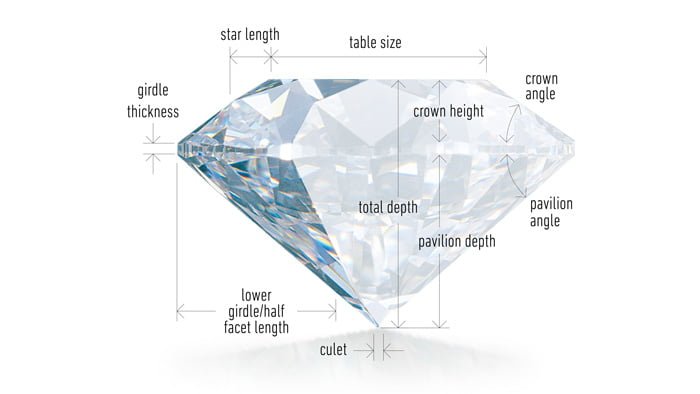
The cut of a diamond is graded on a scale from Excellent to Poor, with several subcategories in between:
- Excellent: The diamond reflects almost all light that enters it and has maximum fire and brilliance.
- Very Good: The diamond reflects most light that enters it and has very good fire and brilliance.
- Good: The diamond reflects a majority of light that enters it and has good fire and brilliance.
- Fair: The diamond reflects some light that enters it and has fair fire and brilliance.
- Poor: The diamond reflects very little light that enters it and has poor fire and brilliance.
When a diamond is cut too shallow or too deep, it can affect the way it reflects light and its overall appearance. A well-cut diamond will have a symmetrical shape, with the table (the flat surface on the top of the diamond) and the culet (the point at the bottom of the diamond) properly aligned.
The cut of a diamond is also important in determining its overall value. A well-cut diamond will be more valuable than a poorly cut one, even if they have the same carat weight and clarity grade.
When choosing a diamond, it is important to consider the cut in relation to the other 4Cs. A diamond with a higher cut grade may have a higher value, even if it has a lower carat weight or clarity grade.
Color:
Diamond color refers to the presence or absence of color within a diamond. The most valuable diamonds are colorless, while lower-quality diamonds may have a yellow or brown tint. The color of a diamond is graded on a scale from D (colorless) to Z (light yellow or brown), with several subcategories in between.

The color grading scale is as follows:
- D, E, F: Colorless diamonds with no visible color
- G, H, I, J: Near-colorless diamonds with a slight hint of color
- K, L, M: Faint yellow diamonds with a noticeable yellow tint
- N, O, P, Q, R: Very light yellow diamonds with a noticeable yellow tint
- S, T, U, V, W, X, Y, Z: Light yellow or brown diamonds with a noticeable yellow or brown tint
Diamonds with higher color grades are rarer and more valuable. However, it is important to note that diamonds with lower color grades can still be beautiful and have a good value, especially if they are well-cut and have high clarity grades.
Conclusion
When choosing a diamond, it is important to consider the color grade in relation to the other 4Cs. A diamond with a lower color grade may have a higher carat weight or a better cut, which can make it more visually appealing and valuable overall.
Overall, diamond color is an important factor to consider when purchasing a diamond, but it should not be the only factor. It is important to find a balance between color and the other 4Cs to ensure that you are getting a high-quality diamond that meets your needs and budget.

